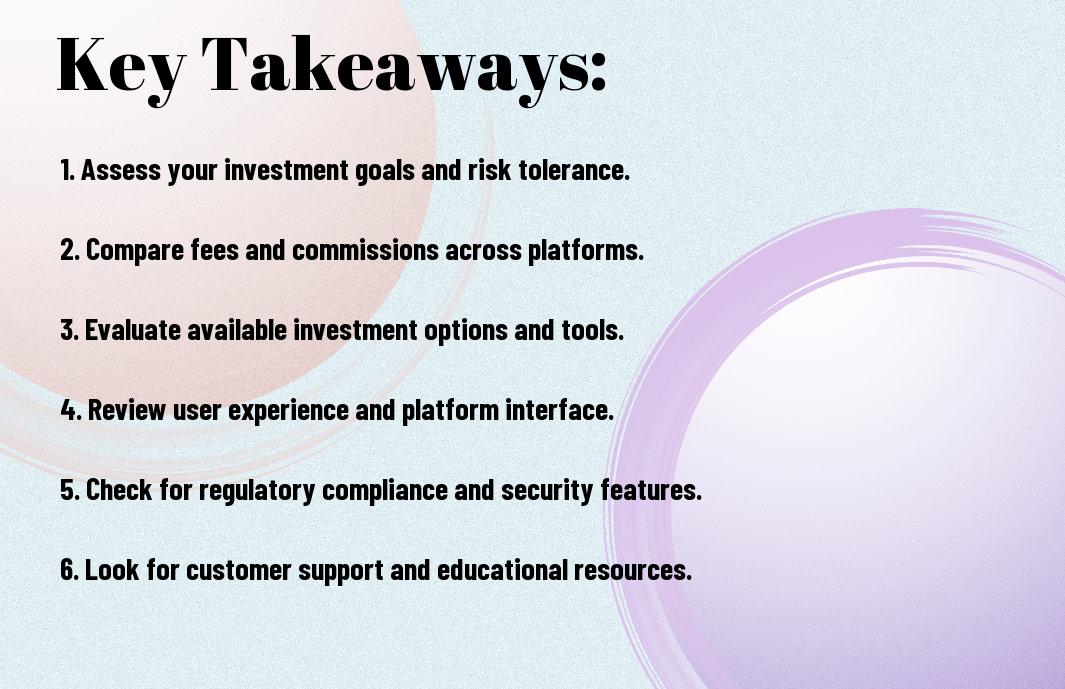Over the past few years, the options for investment platforms have expanded dramatically, making it necessary for you to choose one that aligns with your financial goals and investment style. With various features, fees, and tools available, understanding what to look for can empower you to make informed decisions. Whether you are a novice investor or a seasoned trader, this guide will help you assess your needs and select the right platform that suits your investment journey.

Key Takeaways:
- User Experience: Look for a platform with an intuitive interface that makes navigating and executing trades easy.
- Fees: Evaluate the fee structure, including commissions, account maintenance, and any hidden charges, to ensure it aligns with your investment strategy.
- Investment Options: Confirm that the platform offers a wide range of investment products such as stocks, bonds, ETFs, and mutual funds that suit your needs.
- Research Tools: Assess the availability of analytical tools, educational resources, and research support to facilitate informed investment decisions.
- Customer Support: Ensure the platform provides reliable customer service, including multiple contact options, in case you need assistance.

Understanding Different Investment Platforms
As you consider your investment journey, it’s necessary to understand the varied landscape of investment platforms available. Each platform caters to different needs, investment styles, and investor profiles. Familiarizing yourself with each type allows you to make informed choices that align with your financial goals.
Types of Investment Platforms
Before stepping into investments, it’s vital to identify the types of platforms available. You can categorize them as follows:
| Robo-Advisors | Automated platforms offering portfolio management, typically for lower fees. |
| Brokerage Firms | Traditional firms that offer a broad range of investment options and services. |
| Investment Apps | User-friendly mobile applications that allow easy access to trading. |
| Peer-to-Peer Lending | Platforms connecting borrowers with investors directly, often for higher returns. |
| Real Estate Crowdfunding | Platforms that allow investments in real estate projects collectively. |
Thou must assess each type to decide which aligns best with your investment preferences.
Features to Consider
Above all, it’s vital to evaluate the features offered by investment platforms. Look for factors such as commission fees, account minimums, user experience, available investment options, and customer support services, as these will significantly influence your investing experience.
Consequently, understanding features like educational resources, trading tools, and account types can enhance your investment strategy. Some platforms provide additional research reports, while others focus on social trading features or retirement accounts. Evaluate which features matter most to you to ensure your selected platform aligns with your investment aspirations and helps you navigate your financial future seamlessly.
Evaluating Fees and Costs
You need to carefully analyze the fees associated with your chosen investment platform, as they can significantly affect your overall returns. For insights on what to consider, refer to our guide on How to Choose an Investment Platform in 2024. Understanding the types of fees can help you make informed decisions.
Types of Fees
|
Any of these fees can impact your investment strategy, so assess them carefully before you commit. |
Impact on Returns
For any investment, the fees you pay can have a substantial impact on your returns over time. Higher costs can erode your profits, making it important to factor these expenses into your overall investment strategy.
Due to the compounding nature of investment returns, even seemingly small fees can lead to significant differences in your final portfolio value. By understanding all associated costs, you can choose a platform that maximizes your potential returns and aligns with your investment goals.
Assessing Security and Regulation
Once again, when choosing an investment platform, it’s important to assess the security and regulation factors that protect your assets. A trustworthy platform will adhere to industry regulations and employ robust security measures to safeguard your personal information and investments. By conducting thorough research, you can ensure that your chosen platform prioritizes security and compliance, providing you with peace of mind while you invest.
Importance of Regulation
Regulation in the financial sector serves to protect investors like you from potential fraud and malpractice. By choosing a platform regulated by reputable authorities, you can ensure that it follows strict guidelines meant to uphold transparency, accountability, and fair trading practices. This regulatory oversight ultimately enhances your confidence in the platform and safeguards your investments.
Security Features to Look For
About selecting an investment platform, security features should be a top priority. Look for platforms that offer strong encryption, two-factor authentication, and regular security audits. Additionally, consider whether the platform has insurance coverage to protect your funds in case of a security breach. With these measures in place, you can invest with greater confidence, knowing your assets are well protected.
Importance of security features cannot be overstated; they provide you with an extra layer of protection against potential threats. By utilizing encryption and two-factor authentication, for example, the platform ensures unauthorized users cannot easily access your account. Furthermore, regular security audits help identify and rectify vulnerabilities, making the platform more resilient against breaches. Ensuring that your investment platform prioritizes these security measures is key to maintaining your financial safety and confidence in your investment journey.
User Experience and Accessibility
To choose the right investment platform, consider how user-friendly and accessible it is for your needs. A seamless experience can make managing your investments less stressful, allowing you to focus on making informed decisions. Evaluate the platform’s design, navigation, and support options to ensure they align with your preferences.
Interface Usability
Before you commit to an investment platform, assess its interface usability. It should be intuitive, making it easy for you to execute trades, track your portfolio, and access research tools. A well-designed interface reduces the learning curve and improves your overall trading efficiency.
Mobile Accessibility
By opting for a platform that offers mobile accessibility, you can manage your investments on-the-go. Look for applications that are user-friendly and provide robust features so you can trade, research, and monitor your portfolio whenever you need to.
Due to the increasing reliance on mobile technology, having a strong mobile platform is vital for modern investors. A dedicated app should offer all the functionalities of the desktop version, ensuring you can execute trades, view market data, and analyze your investments seamlessly. With responsive design and features tailored for touch navigation, you can stay informed and make quick decisions no matter where you are.
Research and Analytical Tools
Your investment platform should provide robust research and analytical tools tailored to your needs. These features can empower you to make informed decisions, helping you analyze market trends, assess risks, and evaluate potential outcomes. A platform rich in research resources can elevate your trading strategy, giving you a competitive edge in the financial market.
Importance of Research Tools
Tools designed for research enable you to probe deeper into market data, understand asset performance, and identify investment opportunities. Effective research tools enhance your ability to formulate sound investment strategies based on empirical evidence, rather than relying solely on instinct or market speculation.
Comparing Analytical Features
Among the features you should consider when choosing an investment platform are the types of analytical tools offered. Assessing the following can help you identify the best fit for your trading style.
Comparative Features Table
| Feature | Description |
|---|---|
| Charting Tools | Visual tools for tracking asset performance over time. |
| Technical Indicators | Metrics to predict future price movements. |
| Risk Assessment Tools | Instruments to evaluate potential investment risks. |
| Market Research Reports | Comprehensive insights into market trends and forecasts. |
But evaluating the extent and quality of these analytical features is necessary for your investment success. You must consider how each platform supports different analytical methodologies, such as fundamental analysis versus technical analysis. Look for platforms that offer customization options, allowing you to tailor the tools to your trading strategy and preferences.
Further Comparative Features Table
| Feature | Platform A |
|---|---|
| Backtesting Capability | Available |
| Real-time Data | Limited |
| Integrated News Feed | Yes |
| Educational Resources | Extensive |
Customer Support and Resources
Many investors overlook customer support when selecting an investment platform, yet it can significantly impact your experience. Quality support can help you navigate the complexities of investing. To learn more, check out The Complete Guide to Choosing an Online Stock Broker.
Types of Support Available
Along with initial platform selection, the types of support offered can vary widely. Here are some common options you might find:
| Live Chat | Instant support from representatives |
| Email Support | Written inquiries for non-urgent matters |
| Phone Support | Direct, real-time assistance |
| FAQs | Self-service answers to common questions |
| Community Forums | Peer support and discussions |
Knowing the types of support available will help you choose a platform that meets your needs effectively.
Educational Resources Offered
At this stage, consider the educational resources available to you. A platform that provides comprehensive tutorials, webinars, and articles can empower you to make informed decisions.
Available resources might include market analyses, investment courses, and even simulation tools to practice trading. These resources can be invaluable as they build your confidence and help you enhance your investing knowledge. Utilize these offerings to maximize your potential on the platform and make informed investment choices.
Conclusion
To wrap up, selecting the right investment platform requires evaluating your personal investment goals, understanding the fees involved, and ensuring the platform’s features align with your trading style. Look for user-friendly interfaces, robust security measures, and responsive customer support. By taking the time to research and assess your options, you empower yourself to choose a platform that best suits your needs, ultimately enhancing your investment experience.
FAQ
Q: What factors should I consider when selecting an investment platform?
A: When choosing an investment platform, consider several key factors: first, assess the types of investments offered, such as stocks, bonds, ETFs, or mutual funds; they should align with your investment goals. Next, look at the fees involved, which can vary significantly between platforms, including trading commissions and account management fees. Additionally, evaluate the platform’s user interface and accessibility; a user-friendly design can enhance your overall experience. Lastly, check for educational resources and customer support to ensure you have the guidance you may need, especially if you are new to investing.
Q: How do I determine if an investment platform is reputable and trustworthy?
A: To evaluate the credibility of an investment platform, start by examining its regulatory compliance; platforms should be registered with relevant authorities such as the SEC or FINRA in the United States. Look for user reviews and testimonials to gain insight into the experiences of other investors. Additionally, consider the platform’s history and financial stability, as a long-standing reputation often indicates reliability. Investigating the security measures in place to protect your information and funds is also vital, such as encryption technology and insurance coverage for account balances.
Q: Can I tailor my investment strategy based on the features offered by the platform?
A: Yes, many investment platforms provide customizable features that allow you to tailor your investment strategy. Look for platforms that offer advanced trading tools, such as charting software, and analysis features to help you make informed decisions. Some platforms offer options for automated investing or robo-advisors, which can create a diversified portfolio based on your risk tolerance and investment objectives. Additionally, ensure that the platform allows for flexible account types, such as individual brokerage accounts, retirement accounts, and tax-advantaged options, which can further align the investment process with your personal strategy.
